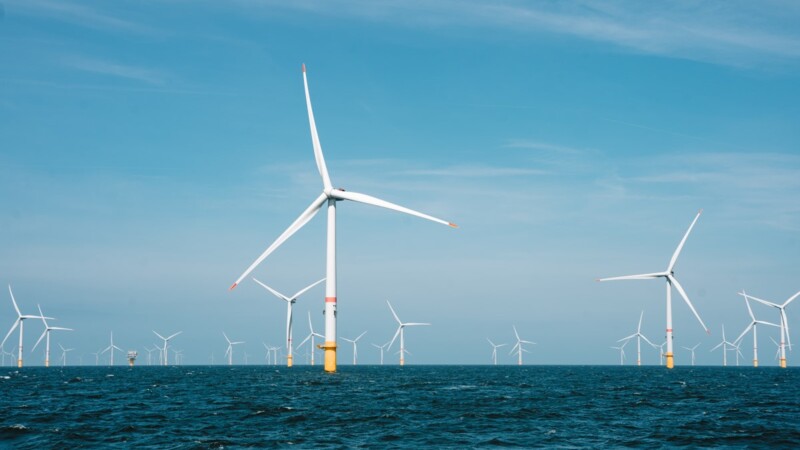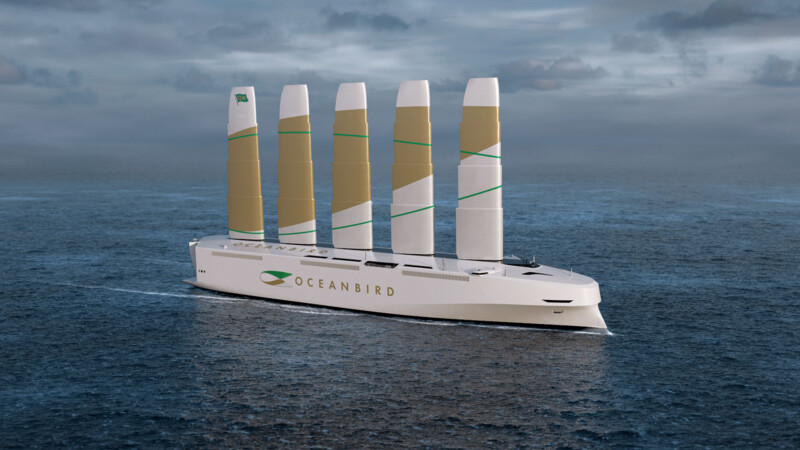The fully automated flying winch energy system can be operated 24/7. "The plastic cable is another important component," said Wrage. "This very strong, lightweight plastic fibre is ten times lighter than steel, but just as strong." The whole system is containerised and therefore mobile. During launch, the folded kite is lifted out of the container by the launch and recovery mast and unfolds to its full size when it has reached a sufficient altitude. "Our kite is 120 to 240 square metres in size, depending on the location and the prevailing wind strength," said Wrage.
The kite flies higher and higher until it reaches an altitude of around 750 metres in strong, steady winds. The kite flies a series of figure eight loops to maximise its flying power. Once 800 metres of rope has been unwound, the kite begins to dive before the next ascent. Commenting on this flying winch energy system, Stephan Wrage, founder of SkySails Power GmbH, said: "It's a bit like a yo-yo." The pulling force of the cable drives a generator and produces electricity. The generated energy pulls the cable back in, using only a fraction of the green electricity. The whole process is controlled by a flying robot. "It is in a box under the kite - just like the pilot under a paraglider. It controls the entire energy system of the flying winch autonomously and ensures an energy-optimised flight." Developing this special flying robot holds great potential for the digitalisation of wind energy, according to Wrage, who is also an industrial engineer and has vast experience of towing kites to support ship engines.
Kites of 120 to 240 square metres in size

Real operation in Mauritius
A 240-square metre kite that "harvests wind" 24/7 - won't it come into conflict with other airspace users? "German airspace is very busy. If we reach the 750 metres, we become an obstacle," Wrage pointed out. Conventional wind turbines are usually between 150 and 200 metres in height. Any operation at an altitude of under one kilometre requires planning and must be co-ordinated with other aircraft in the airspace. But that is still a long way off. For now, SkySails is focussing mainly on island regions such as Taiwan, the Philippines, French Polynesia and Mauritius, where the company put a system into operation last year. "The experience gained from real operations is immediately incorporated into further development," Wrage stressed. At present, the SkySails airborne wind turbine is generating 400 megawatt hours per annum. "We can supply 200 to 400 households, depending on the region. Our goal is to double this output by improving the control system and kite."

Functioning system certified by expert
An expert report by Windtest Grevenbroich GmbH certified the functioning of the system in March by testing the power curve. "We have a stable, high-altitude wind energy system that achieves reproducible results and are proud to have confirmed the world's first verified and audited wind power curve," said Wrage. The SkySails wind turbine was assessed in Klixbüll in Schleswig-Holstein (Hamburg Metropolitan Region), where the high-altitude wind energy technology already demonstrated its relevance between 2019 and 2022 as part of the SkyPower 100 joint project. At the time, the test operation sought to validate the operating conditions, energy production and cost-effectiveness of autonomous long-term operation along with partners including Skysails, EnBW, Omexom and the Leibniz University of Hanover. The project was organised by the Jülich Research Institute and funded by the German Ministry of Economics and Energy.
4,000 potential locations in Germany
Germany is keen to use high-altitude wind energy. In April, onshore wind power was included in the latest version of the Renewable Energy Sources Act. So will the SkySails kite be taking to the skies all over Germany soon? "We have actually identified over 4,000 potential sites in Germany and 90 per cent of them are unsuitable for conventional wind turbines." The system must grow before Wrage can undertake this endeavour. "There is a huge demand for electricity in Germany and correspondingly large turbines are needed, which we will also develop." SkySails systems can make an important contribution to the energy transition even before they are fully developed. "The future lies in the mix. We all need climate neutrality as soon as possible."
ys/pb
Sources and further information
More
Similar articles

EEHH keeping a close eye on energy transition

Ørsted now building two new offshore wind farms in North Sea

Wind power going green
